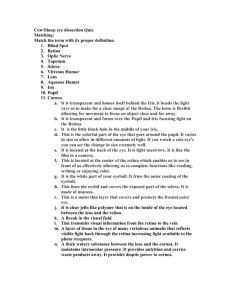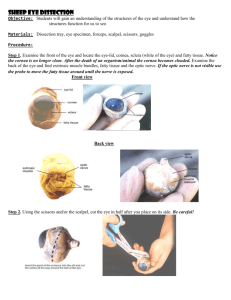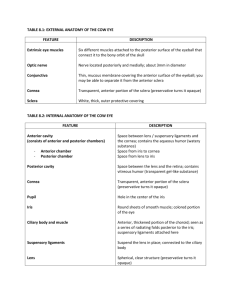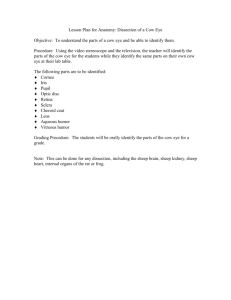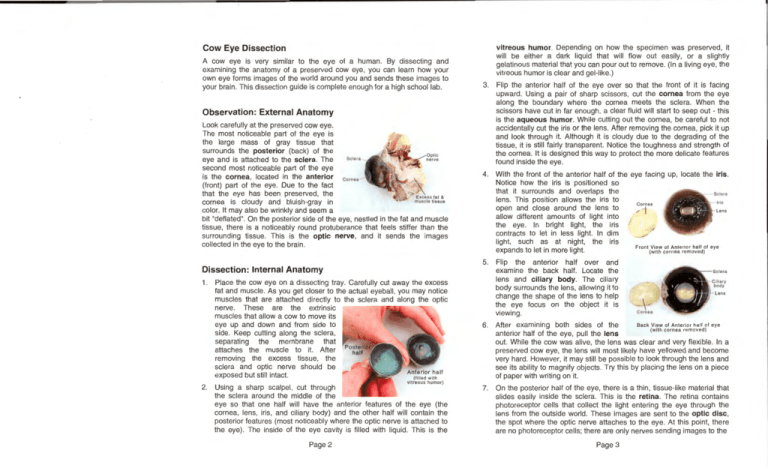
vitreous humor. Depending on how the specimen was preserved , it
will be either a dark liquid that will flow out easily, or a slightly
gelatinous material that you can pour out to remove. (In a living eye, the
vitreous humor is clear and gel-like.)
Cow Eye Dissection
A cow eye is very similar to the eye of a human . By dissecting and
examining the anatomy of a preserved cow eye, you can learn how your
own eye forms images of the world around you and sends these images to
your brain. This dissection guide is complete enough for a high school lab.
3.
Observation: External Anatomy
Look carefully at the preserved cow eye .
The most noticeable part of the eye is
the large mass of gray tissue that
surrounds the posterior (back) of the
Opti c
Scie ra
nerv e
eye and is attached to the sclera. The
second most noticeable part of the eye
is the cornea , located in the anterior cornea
(front) part of the eye . Due to the fact
that the eye has been preserved, the
cornea is cloudy and bluish-gray in
color. It may also be wrinkly and seem a
bit "deflated". On the posterior side of the eye, nestled in the fat and muscle
tissue, there is a noticeably round protuberance that feels stiffer than the
surrounding tissue. This is the optic nerve, and it sends the images
collected in the eye to the brain .
4. With the front of the anterior half of the eye facing up, locate the iris .
Notice how the iris is positioned so
that it surrounds and overlaps the
lens. This position allows the iris to
Iri s
Cornea
open and close around the lens to
Lens
I
allow different amounts of light into
the eye. In bright light, the iris
contracts to let in less light. In dim
light, such as at night, the iris
Front View of Anterior half of eye
expands to let in more light.
(with co rn ea remove d)
5.
Dissection: Internal Anatomy
1.
2.
Place the cow eye on a dissecting tray. Carefully cut away the excess
fat and muscle . As you get closer to the actual eyeball , you may notice
muscles that are attached directly to the sclera and along the optic
nerve. These are the extrinsic
muscles that allow a cow to move its
eye up and down and from side to
side. Keep cutting along the sclera,
separating the membrane that
attaches the muscle to it. After
removing the excess tissue, the
sclera and optic nerve should be
exposed but still intact.
(filled with
Flip the anterior half of the eye over so that the front of it is facing
upward. Using a pair of sharp scissors, cut the cornea from the eye
along the boundary where the cornea meets the sclera. When the
scissors have cut in far enough , a clear fluid will start to seep out - this
is the aqueous humor. While cutting out the cornea, be careful to not
accidentally cut the iris or the lens. After removing the.cornea, pick it up
and look through it. Although it is cloudy due to the degrading of the
tissue, it is still fairly transparent. Notice the toughness and strength of
the cornea. It is designed this way to protect the more delicate features
found inside the eye.
Flip the anterior half over and
examine the back half. Locate the
lens and ciliary body. The ciliary
body surrounds the lens, allowing it to
change the shape of the lens to help
the eye focus on the object it is
viewing .
Sciera
-----....,
'
Lens
-\
Cornea
Back View of A nterior hal f of eye
6. After examining both sides of the
(wit h co rn ea removed)
anterior half of the eye, pull the lens
out. While the cow was alive, the lens was clear and very flexible . In a
preserved cow eye, the lens will most likely have yellowed and become
very hard. However, it may still be possible to look through the lens and
see its ability to magnify objects. Try this by placing the lens on a piece
of paper with writing on it.
vitreo us humor)
Using a sharp scalpel , cut through
the sclera around the middle of the
eye so that one half will have the anterior features of the eye (the
cornea, lens, iris , and ciliary body) and the other half will contain the
posterior features (most noticeably where the optic nerve is attached to
the eye) . The inside of the eye cavity is filled with liquid . This is the
Page 2
7. On the posterior half of the eye, there is a thin , tissue-like material that
slides easily inside the sclera. This is the retina . The retina contains
photoreceptor cells that collect the light entering the eye through the
lens from the outside world. These images are sent to the optic disc,
the spot where the optic nerve attaches to the eye. At this point, there
are no photoreceptor cells ; there are only nerves sending images to the
Page 3
brain. Because of this, this place in the eye is often referred to as the
blind spot since no images can be formed here. To compensate for
this blind spot, the other eye often sees the images that the first eye
cannot see and vice versa. In the rare occasions where neither eye can
see a particular spot, the brain "fills in" the spot using the surrounding
background information it receives from the eye .
8.
9.
Most of the retina is not attached
to the eye. Instead, it is held in
place by fluids in the eye. The
tissue of the retina gathers at the
back of the eye where it forms into
the optic nerve. This is the only
place where the retina is attached
to the eye. Use a pair of tweezers
to gently lift the retina off the
inside wall of the eye. The retina
may tear because it is very
delicate. Underneath the retina you will find a very shiny and colorful
tissue. This is the choroid coat. The choroid coat is also known as the
vascular tunic because it supplies the eye with blood and nutrients. In a
human eye, the choroid coat is very darkly colored to minimize the
reflection of light which would cause distorted images.
Cow Eye
Dissection Guide
Notice that the choroid coat in the cow's eye is very colorful and shiny.
This reflective material is the tapetum lucidum , and its reflective
properties allow a cow to see at night by reflecting the light that is
absorbed through the retina back into the retina. (While this does allow
the cow to see better at night than humans can, it distorts the clarity of
what the cow sees because the light is reflected so much .) The tapetum
lucidum is also responsible for the "glowing" eyes of animals, such as
cats, when a small amount of light reflects off the tapetum lucidum in an
otherwise dark room .
HOffiE ~~Il~~~~ TOOLS
THE GATEWAY TO DISCOVERY
665 Carbon Street, Billings, MT 59102
Phone: 800.860.6272
Fax: 888.860.2344
www.homesciencetools.com
Copyright 2007 by Home Training Tools, Ltd . All rights reserved .
Page 4




